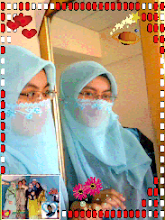Assalamualaikum
Hello
Salam sejahtera
Konnichiwa
Da jia hao
What comes to your mind when you read those 5 phrases?
Hmm...come to think about it, do u realize that those phrases are the phrases that people will use when they meet each other? I come up with those 5 phrases, which comes from 5 languages.
'Assalamualaikum' is an Arabic language, use by muslim. 'peace be upon you' in English is the translate word of 'Assalamualaikum'. For Englishman, usually they will say 'hello' or 'hi' when they meet each other. The third phrase, 'salam sejahtera' is in Bahasa Malaysia. 'Konnichiwa' is a Japanese word, also for greetings. Lastly, 'Da jia hao' is a Chinese word.
Those greetings phrases are multilingual. What do you think about people who can converse in multilanguages?In contrast, what do you think of people who only know 1 language?
Of course in either learning process or in any careers, people who can communicate in several languages have their own speciality. In learning process,you can get much information if you know many languages. Each languages in this world has their own uniqueness. Through the language itself, you will know the culture of the people,their habit and their interest. Wonderful, isn't it?Knowledge is infinity. So, as we live, we should learn as many as we can.
Learning foreign languages give us satisfaction that can't be pictured. It is a really wonderful feeling. Actually, I can converse in 4 languages, which are Malay, English, Japanese and Chinese(Mandarin). I feel that language is a very interesting subject to learn. In the university I learn Japanese and Mandarin as an audit course. I learned Japanese through out Semester 1-3 since only 3 levels are available.Alhamdulillah, I got 'A's for all levels.(^-^) Honto ni ureshii! Arigatou gozaimasu,sensei!
During semester 4, I just entered the Japanese class just for fun without fomal registration. Sensei also glad that I entered her class anyway.Hmm...may be she wanted me to improve my Nihongo and to avoid the forgetnessess of the Japanese words.Frankly speaking, after each Japanese class session, I felt very happy. I don't know how to explain why I behave like that. But, one thing for sure, that is what we call it ' THE SATISFACTION OF LEARNING LANGUAGES'. It really makes my mind become fresh and relax as I enjoyed the class very much.
Let me share with you one story. During semester 4, failed my mid-term paper for Fundamental Organic Chemistry( Kimia Organik Asas). At that time, I felt really dumb, frustrated, and felt that I'm the stupidest student in the class. I felt really really sad. To overcome my sadness and release the tension and stress, I attended Japanese class at the evening. You know what happened in the class? I enjoyed the lesson so much and automatically I didn't think about the sadness anymore! How amazing! Then after the class I felt more relax and can think more wisely. I grew back my confidence. I said that 'InsyaAllah, Insyirah, you can do it next time! Failure is the key to gain more successful in life!Ganbatte kudasai!'
See, how powerful the enjoyment of learning something you enjoy the most in your life. It gives positive impacts that can cure your sadness and boost your confidence.
Ok, let's continue with my story. Now, in Semester 5 I learn Mandarin as an audit course. Laoshi is an interesting person. He is full of humor and makes the class alive. Two ways communications between laoshi(teacher) and xuesheng(student) is really enjoyable. After the class, I also feel the same feeling like the Japanese class. I feel more relax and feel very happy. Learning new words, phrases and the culture of the people really makes my mind fresher and build new cells in my brain. Why I said so? According to my readings, each time we learn new things, our brain will process it.You will think and think. Then, new cell will be generated. So, if you want to avoid yourself from become forgetful when you get older(nyanyuk), try to learn something new and of course read books and the Quran everyday!
Let me share with you. Today, we have to do the simulation in the Mandarin class. Each students have to introduce themselves in Mandarin.Here is the draft of what I said as I introduced myself:
Da jia hao! Wo jiao Insyirah.Wo ershiyi sui.Wo laizi Jilandan.Wo shi xuesheng. Wo zai Sudan Yi de Lisi Shifan Daxue nianxu.Wo yao papa,mama, liang ge meimei, san ge didi.Wo xihuan kan daishi, bu xihuan kanshu. Xiexie.
Learning languages is a therapy for me. It is really powerful. That's why I feel the satisfactoy in learning multilanguages . Well said, IT IS THE POWER OF WORDS'
































